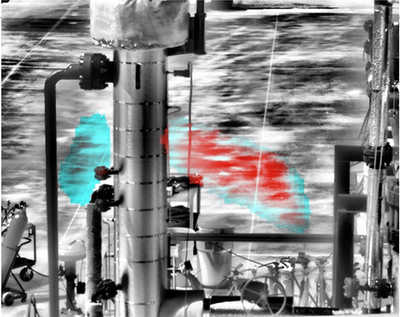Background
In 2016 SwRI received funding from the Department of Energy’s National Energy Technology Laboratory to develop an autonomous, reliable, real-time methane leak detection technology, the Smart Methane Leak Detection (SLED) system, which applies machine learning techniques to passive optical sensing modalities to mitigate emissions through early detection. The program has progressed through multiple phases over three years. SwRI met with DOE NETL project managers in November 2019 and proposed a fourth phase of funding to expand the scope of the project to include quantification in conjunction with current detection capabilities. DOE has approved this new phase for funding. The proposed scope of work for the project phase extension is 18 months at just under $1.09 million, requiring a 20% cost share. This project will contribute in-kind labor as a cost share to the DOE program.
 Figure 1: Methane Detection using Optical Gas Imager with Deep Learning Segmentation algorithm.
Figure 1: Methane Detection using Optical Gas Imager with Deep Learning Segmentation algorithm. Approach
The objective of this research is to adapt the current methane detection research to be able to quantify methane after detection. By augmenting the Optical Gas Imaging (OGI) camera with Long wave Infrared (LwIR) thermal camera, visible camera, and atmospheric information, in conjunction with computational fluid dynamics (CFD) modeling and combined with statistical modeling and machine learning/deep learning, we aim to build a system that can detect methane leaks, pinpoint the leak source(s) estimate the leak rates in near real-time, and display this information to the operator without needing to rely on several high cost tools for detection and then quantification.
Accomplishments
The OGI, LwIR thermal and visible camera, along with a LiDAR module and weather sensor were all mounted and aligned to be co-planar, a unified software suite developed for reading the sensors, time synchronizing the data, and registering images from different modalities together. CFD models were investigated and codified for use in analyzing the plumes, and later used in guiding the machine learning efforts. Furthermore, a data collection containment area was constructed to prevent interference from external wind conditions and to control the speed and direction of the methane plume during data collection.
